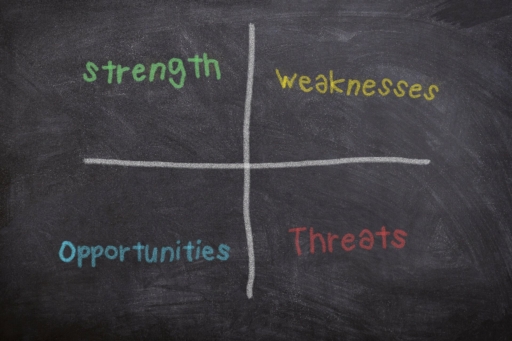What is the purpose of a SWOT analysis for my company?
Behind this table, also known as the SWOT matrix, lies an analysis tool. It allows you to look at your company from both an internal and an external perspective. You can also use this tool for a product or a project.
The SWOT is used in many important documents such as the business plan or the marketing plan.
We will explain the benefits of doing this for your business whether you are self-employed, a VSE, SME, ETI or large group.

What are the benefits of SWOT analysis?
The first advantage is that you do not have to not necessarily need external support. The first step is to ask yourself questions about your organisation by taking a step back.
You will quickly identify what works and what needs to be improved. You will then be able to prioritise the items in order of importance.
The second advantage is that you do not have to no need to invest in a tool to carry out this analysis.
Finally, the SWOT analysis allows you to take a step back from your short, medium and long term goals and plan.
How to do a SWOT in practice?
The first step is to take a factual look at 4 dimensions: the strengths, weaknesses, opportunities and threats of your company.
The internal view is concerned with elements that are internal to the company and therefore independent of the external context:
- Strengths, the strengths of your company - What makes you different? Examples: low fixed costs, unique know-how, strong reputation, product quality, low turnover, cash management efficient, ...
- Weaknesses, weaknesses - What are your points of improvement? Examples: organisation in silos, poorly formalised working methods, management tools lack of automation, lack of visibility to customers, poor risk management, etc.
The external view shows the possible impacts on your organisation:
- Opportunities, opportunities - What helps to boost your business? Examples: new investment programmes, market growth of +3% in the last 2 years, lower interest rates, ...
- Threats, threats - What limits your development and makes your organisation vulnerable? Examples: compliance with regulations, image of the sector, increasing competition and decreasing margins, etc.

How do I do the SWOT analysis for my company?
The second and most interesting step is to cross-reference the four dimensions.
In short, you will be able to understand the context in which your company is evolving. It is always good to formalise this analysis in order to make useful decisions and write your action plan.
- Strengths and Opportunities Cultivate and develop your strengths to turn them into levers of development and benefit from the opportunities identified.
- Weaknesses and Opportunities Identify the resources and means you need to improve and seek opportunities.
- Strengths and Threats Use your strengths to make your organisation less vulnerable to the external environment.
- Weaknesses and Threats Risk management: mastering the lack of assets exposes the sustainability of your organisation. You need to assess the risks in order to decide how to deal with them and protect your company and its resources. Be careful, this does not mean making an in-depth analysis of all the risks (see article "Risk management").
Our advice: Conclusion
- Set clear strategic objectives for your business because it is the course to be followed, maintained or adapted according to the SWOT analysis.
- Make a listIf possible, a balanced diet, on each of the 4 dimensions of the SWOT based on facts and involving the right people. Depending on the size of your company this document may be classified as confidential
- Be synthetic. This exercise should enable you to create value and give a global view. It will be easier to update over time.
- Prioritise your actions with milestones to be held in relation to the objectives to be achieved for your company.
- Define roles and responsibilities to act and to choose the internal and/or external resources you need.
- Refine this reading grid with a risk analysis or with more detailed questions depending on the context of your company.